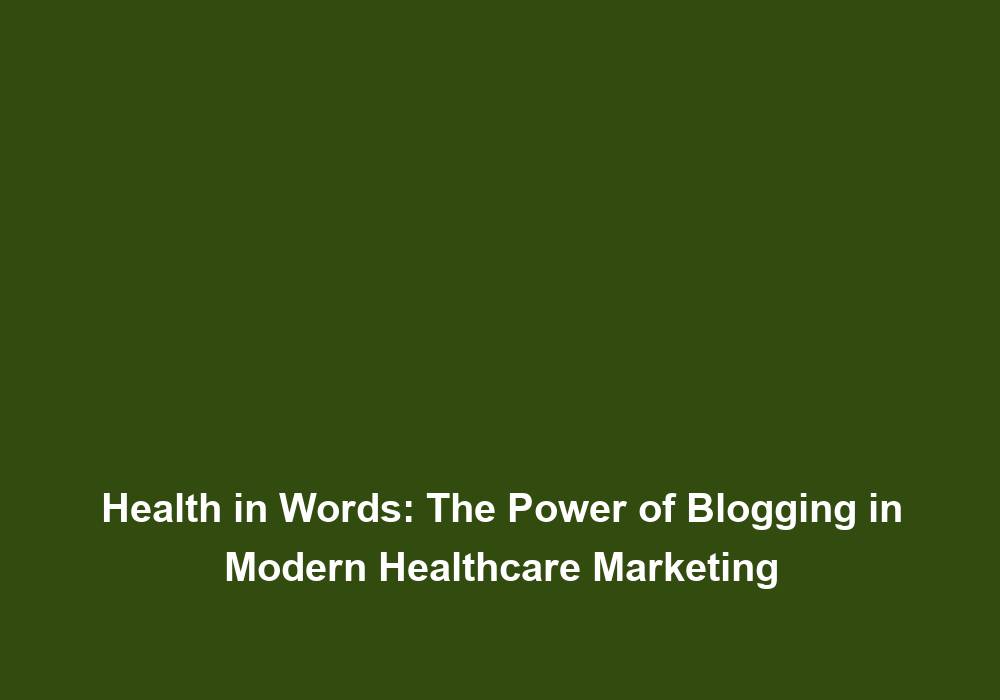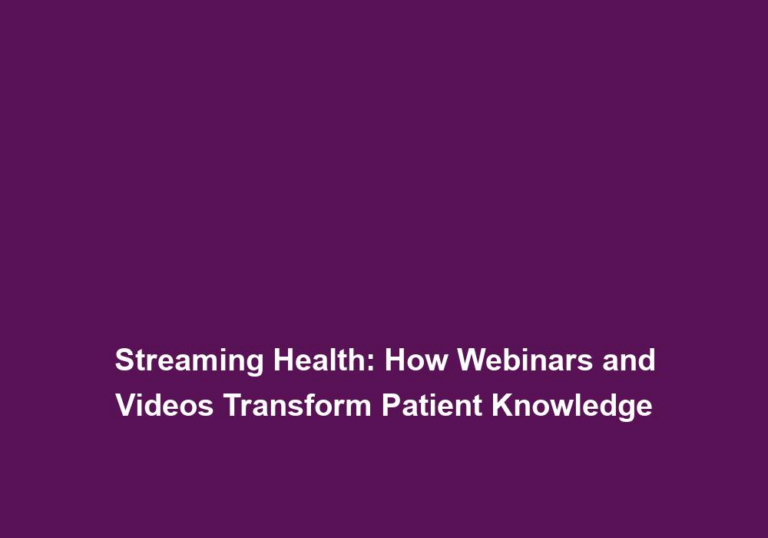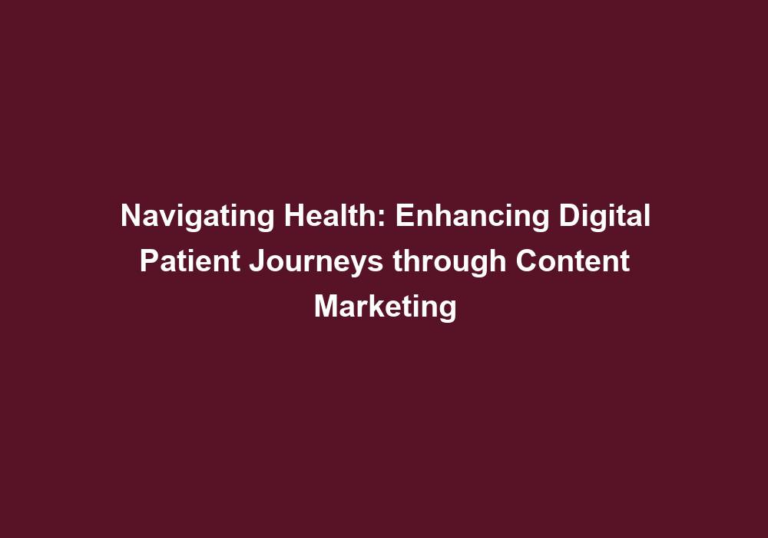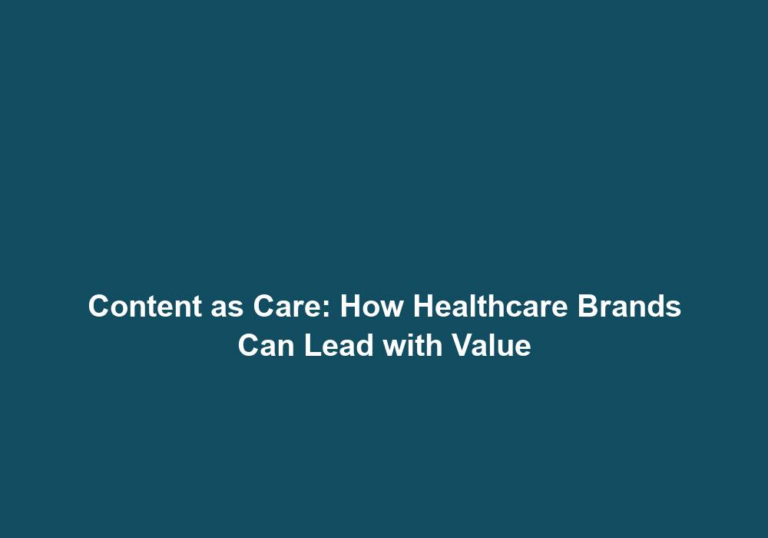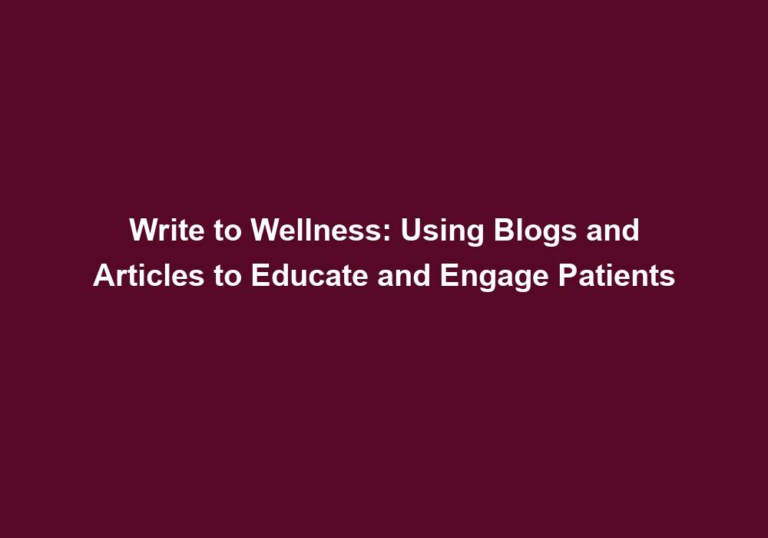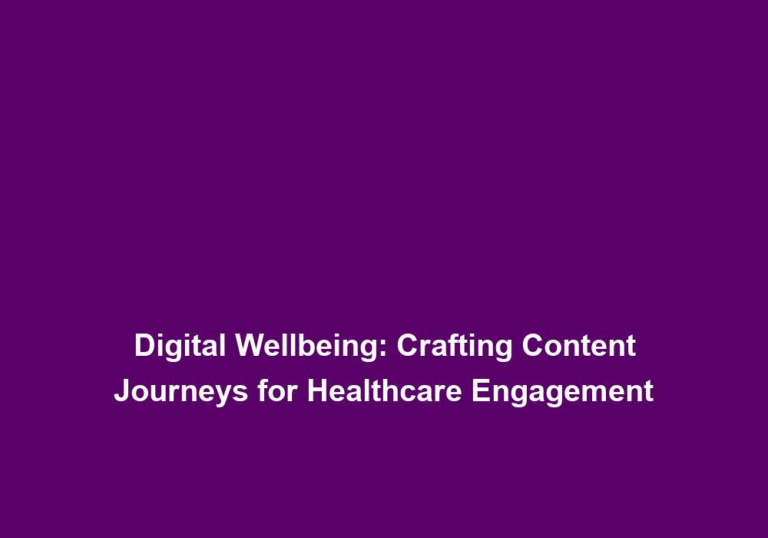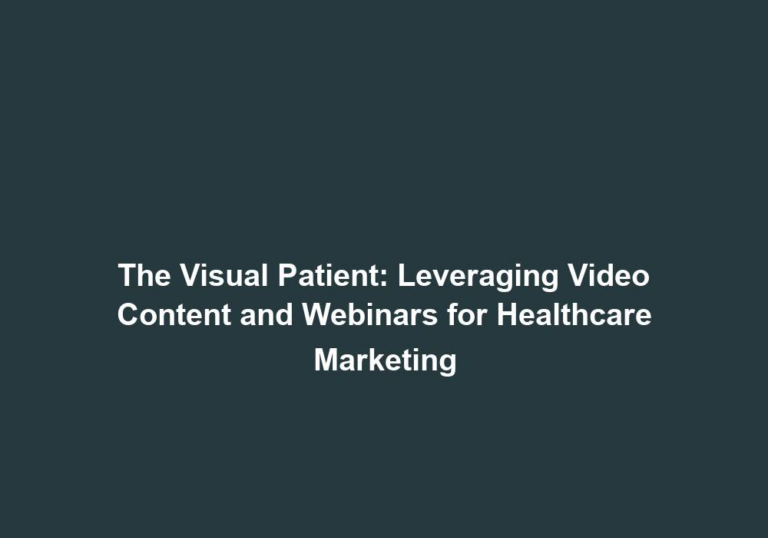Health in Words: The Power of Blogging in Modern Healthcare Marketing
In the fast-paced world of modern healthcare marketing, staying ahead of the competition is essential. In recent years, blogging has emerged as a powerful tool for healthcare organizations to connect with their audience, establish thought leadership, and drive traffic to their websites. This article delves into the significance of blogging in healthcare marketing and how it can benefit both providers and patients.
Why Blogging Matters in Healthcare Marketing
- Building Trust and Credibility: Blogging allows healthcare organizations to showcase their expertise and knowledge in a specific area. By consistently publishing informative and relevant content, they can establish themselves as trusted sources of information. This, in turn, builds credibility among their target audience and helps patients make more informed decisions about their healthcare.
-
By sharing evidence-based research, case studies, and expert opinions, healthcare organizations can instill trust in their audience. Regularly updating the blog with accurate and reliable information demonstrates a commitment to providing valuable content.
-
In-depth articles that delve into complex health topics or offer practical advice can help patients understand their conditions better. By empowering patients with knowledge, healthcare organizations can foster a sense of trust and encourage them to seek further information or consultations.
-
Incorporating patient testimonials and success stories into blog posts can also contribute to building trust. By sharing real-life experiences and outcomes, healthcare organizations can demonstrate their ability to deliver positive results.
- Increasing Website Traffic: Well-written and optimized blog posts can significantly increase a healthcare organization’s website traffic. By incorporating relevant keywords and topics that resonate with their audience, blogs can attract organic search traffic from individuals seeking information on specific health conditions, treatments, or medical advice.
-
Effective keyword research allows healthcare organizations to identify the terms and phrases that potential patients are using to search for information. By strategically incorporating these keywords into blog posts, organizations can improve their search engine rankings and attract more visitors to their website.
-
In addition to keywords, healthcare organizations can optimize their blog posts by including internal and external links. Internal links direct readers to related articles or pages within the organization’s website, increasing engagement and encouraging users to explore more content. External links to reputable sources can also enhance the credibility of the blog post.
-
Creating informative and engaging content that addresses common healthcare concerns can establish the organization as a reliable resource. By providing valuable information, healthcare organizations can attract and retain a loyal readership, leading to increased website traffic and potential conversions.
- Enhancing Search Engine Optimization (SEO): Blogging plays a vital role in improving a healthcare organization’s search engine rankings. Search engines place value on websites that regularly publish fresh, high-quality content. By consistently updating their blog with informative posts, healthcare organizations can enhance their overall SEO efforts and improve their visibility in search engine results pages (SERPs).
-
Regularly publishing new blog posts signals to search engines that the website is active and relevant. This can result in higher rankings and increased visibility in search results.
-
By focusing on specific topics or keywords relevant to their target audience, healthcare organizations can optimize their blog posts for better search engine rankings. This involves using relevant headings, subheadings, and meta tags, as well as structuring the content in a way that is easy to read and understand.
-
Including relevant images, infographics, or videos in blog posts can enhance the overall user experience and attract more organic traffic. Optimizing these multimedia elements with descriptive alt tags and captions further improves the blog’s SEO.
- Engaging and Educating Patients: Blogging provides an excellent platform to engage with patients and educate them about various health-related topics. By addressing common concerns, sharing success stories, or providing useful tips, healthcare organizations can empower patients to take an active role in managing their health. This engagement fosters a sense of loyalty and encourages patients to seek out the services offered by the organization.
-
By utilizing a conversational and empathetic tone in blog posts, healthcare organizations can connect with their readers on a personal level. This can help alleviate patient concerns and establish a relationship based on trust and understanding.
-
Providing practical tips, recommendations, or step-by-step guides can empower patients to make informed decisions about their health. This not only enhances their overall experience but also positions the healthcare organization as a reliable source of guidance and support.
-
Engaging with readers through comments, responding to their questions or concerns, and encouraging them to share their experiences can create a sense of community. This fosters a deeper connection between the organization and its patients, leading to increased loyalty and advocacy.
- Promoting Thought Leadership: Blogging allows healthcare professionals to position themselves as thought leaders in their respective fields. Through well-researched and insightful articles, healthcare organizations can demonstrate their expertise and share their unique perspectives. This not only establishes them as industry leaders but also opens up opportunities for collaborations, partnerships, and speaking engagements.
-
By conducting comprehensive research and staying up to date with the latest advancements in their field, healthcare professionals can provide valuable insights and thought-provoking content. This positions them as trusted authorities and invites further discussions and collaborations within the industry.
-
Sharing original research, case studies, or innovative approaches in blog posts showcases the organization’s commitment to advancing healthcare practices. This can attract attention from other professionals, leading to potential collaborations or speaking engagements at industry events.
-
Encouraging guest contributions from other experts in the field can further diversify the blog’s content and expand its reach. This exchange of ideas fosters a collaborative environment and solidifies the organization’s position as a thought leader.
Best Practices for Effective Healthcare Blogging
Now that we understand the importance of blogging in healthcare marketing, let’s explore some best practices to ensure success:
1. Identify Your Target Audience
Before diving into blogging, it’s crucial to identify and understand your target audience. This will help you create content that resonates with their needs, interests, and pain points. Conducting thorough market research, analyzing demographics, and developing buyer personas can provide valuable insights into your audience’s preferences.
-
Conduct surveys or interviews with your existing patients to gather information about their healthcare needs, preferences, and challenges. This data can help shape your content strategy and ensure that your blog posts address topics that are relevant to your target audience.
-
Analyze website analytics and social media metrics to identify the demographics and interests of your website visitors. This information can guide your content creation process and help you tailor your blog posts to attract and engage your target audience.
-
Stay up to date with industry trends and changes in healthcare regulations or practices. This knowledge will allow you to anticipate the needs of your audience and create timely and valuable content.
2. Develop a Content Strategy
Building a comprehensive content strategy is essential for successful blogging. This strategy should outline your blog’s goals, themes, and topics. Consider the types of content that will be most effective for your audience, such as how-to guides, expert interviews, patient testimonials, or educational articles. Strive for a balance between evergreen content and timely, trending topics to keep your blog fresh and engaging.
-
Define the primary objectives of your blog, whether it’s to educate, inform, entertain, or promote your healthcare services. Aligning your content strategy with these objectives will help maintain consistency and focus in your blog posts.
-
Plan a content calendar to ensure regular and consistent publishing. This calendar should include topics, keywords, and publishing dates. It will serve as a roadmap for your content creation process and help you stay organized.
-
Consider the different formats and mediums that can be used to present your content. This can include written articles, videos, podcasts, infographics, or interactive quizzes. Diversifying your content types can cater to different learning styles and preferences, increasing engagement and reach.
3. Optimize for Search Engines
To maximize the visibility and reach of your blog, optimize your content for search engines. Conduct keyword research to identify relevant search terms and incorporate them naturally throughout your blog posts. Use descriptive meta titles, headings, and meta descriptions to improve your blog’s SEO. Additionally, ensure your website’s technical aspects, such as page loading speed and mobile optimization, are optimized for better search engine rankings.
-
Use keyword research tools to identify high-volume and low-competition keywords relevant to your healthcare niche. Incorporate these keywords strategically in your blog posts, headings, and meta tags. However, it’s important to maintain a natural flow of the content and avoid keyword stuffing.
-
Structure your blog posts with descriptive headings and subheadings. This not only improves readability but also helps search engines understand the context and relevance of your content.
-
Optimize your meta titles and descriptions to entice users to click on your blog post when it appears in search engine results. A compelling and concise description can significantly improve click-through rates.
-
Ensure your website is mobile-friendly and loads quickly. Mobile optimization is crucial as more and more users access the internet through their smartphones. A fast-loading website provides a better user experience and improves your chances of ranking higher in search results.
4. Create Engaging and Shareable Content
Writing engaging content is key to capturing and retaining your audience’s attention. Use storytelling techniques, infographics, or videos to make your blog posts more visually appealing and interactive. Don’t be afraid to inject personality into your writing to create a connection with your readers. Encourage social sharing by incorporating social media buttons and encouraging readers to share your content with their networks.
-
Craft compelling headlines that grab the reader’s attention and entice them to click on your blog post. A catchy headline can significantly increase the chances of your content being read and shared.
-
Incorporate storytelling elements in your blog posts to make them more relatable and memorable. Use real-life examples, anecdotes, or patient stories to illustrate your points and engage readers on an emotional level.
-
Visual elements such as infographics or videos can break up the text and make your blog posts more visually appealing. This enhances the overall user experience and encourages readers to spend more time on your website.
-
Include social media sharing buttons at the end of each blog post to make it easy for readers to share your content with their networks. Encourage readers to share their thoughts and experiences in the comments section, fostering a sense of community and interaction.
5. Promote Your Blog
While high-quality content is essential, it’s equally important to promote your blog effectively. Leverage social media platforms, email newsletters, and partnerships with industry influencers to amplify the reach of your content. Engage with your audience by responding to comments, addressing their concerns, and encouraging them to subscribe to your blog. Regularly share your blog posts across your organization’s social media channels to drive more traffic and increase brand visibility.
-
Create social media profiles for your healthcare organization and actively engage with your audience. Share snippets or teasers of your blog posts on social media platforms, linking back to the full article on your website. Respond to comments, answer questions, and encourage discussion to build a community of loyal followers.
-
Leverage email marketing to promote your blog posts to your existing patient base or subscribers. Send out regular newsletters highlighting your latest blog content and encourage readers to share it with their friends and family.
-
Collaborate with industry influencers or other healthcare professionals to co-create content or cross-promote each other’s blogs. This can help expand your reach and tap into new audiences.
-
Actively monitor and respond to comments on your blog posts. Engage in meaningful discussions, address concerns, and encourage readers to subscribe to your blog for regular updates. Building a responsive and interactive community will increase readership and encourage repeat visits.
Conclusion
Blogging has become a powerful tool in modern healthcare marketing. By leveraging the potential of blogging, healthcare organizations can establish credibility, engage with patients, drive website traffic, and position themselves as thought leaders. By following best practices and consistently delivering valuable content, healthcare organizations can harness the power of blogging to stay ahead in the competitive healthcare landscape.

